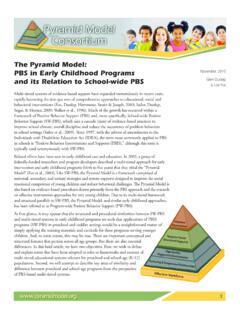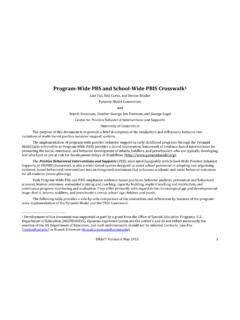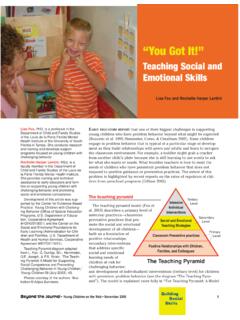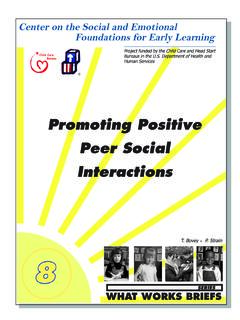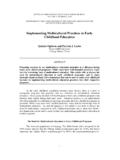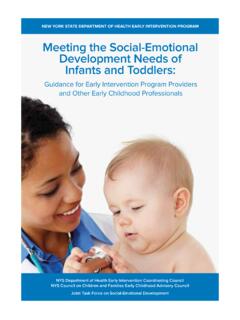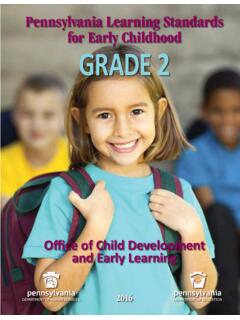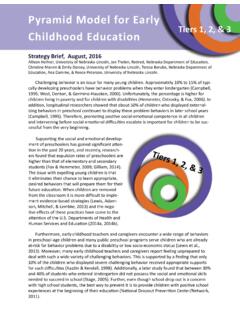Transcription of The Pyramid Model: PBS in Early Childhood Programs ...
1 Pyramid Model: PBS in Early Childhood Programs and its Relation to School-wide PBS Multi-tiered systems of evidence-based support have expanded tremendously in recent years, rapidly becoming the sine qua non of comprehensive approaches to educational, social and behavioral interventions (Fox, Dunlap, Hemmeter, Strain & Joseph, 2003; Sailor, Dunlap, Sugai, & Horner, 2009; Walker et al., 1996). Much of the growth has occurred within a framework of Positive Behavior Support (PBS) and, more specifically, School-wide Positive Behavior Support (SW-PBS), which uses a cascade (tiers) of evidence-based practices to improve school climate, overall discipline and reduce the occurrence of problem behaviors in school settings (Sailor et al., 2009). Since 1997, with the advent of amendments to the Individuals with Disabilities education Act (IDEA), the term most commonly applied to PBS in schools is Positive Behavior Interventions and Supports (PBIS), although this term is typically used synonymously with efforts have been seen in Early Childhood care and education .
2 In 2003, a group of federally-funded researchers and program developers described a multi-tiered approach for Early intervention and Early Childhood Programs (birth to five years) that they titled the Pyramid Model (Fox et al., 2003). Like SW-PBS, the Pyramid Model is a framework comprised of universal, secondary, and tertiary strategies and system supports designed to improve the social emotional competence of young children and reduce behavioral challenges. The Pyramid Model is also based on evidence-based procedures drawn primarily from the PBS approach and the research on effective intervention approaches for very young children. Due to its multi-tiered framework and structural parallels to SW-PBS, the Pyramid Model, and similar Early Childhood approaches, has been referred to as Program-wide Positive Behavior Support (PW-PBS).At first glance, it may appear that the structural and procedural similarities between SW-PBS and multi-tiered systems in Early Childhood Programs are such that applications of PBIS Programs (SW-PBS) in preschool and toddler settings would be a straightforward matter of simply applying the training materials and curricula for these Programs serving younger children.
3 And, to some extent, this may be true. There are important conceptual and structural features that pertain across all age groups. But there are also essential differences. In this brief article, we have two objectives. First, we wish to define and explain terms that have been adopted to refer to frameworks and content of multi-tiered educational systems relevant for preschool and school-age (K-12) populations. Second, we will attempt to describe key areas of similarity and difference between preschool and school-age Programs from the perspective of PBS-based multi-tiered , 2015 Glen Dunlap & Lise and DefinitionsAs an approach, Positive Behavior Support (PBS) has grown in many ways since its inception in the mid-1980s (Lucyshyn, Dunlap, & Freeman, 2015). Initially, PBS developed as an approach for addressing problem behaviors of individuals with severe developmental disabilities and, during its first decade or so, the entire focus of PBS was on the needs of individuals with problem behavior.
4 The approach was known by a variety of terms including nonaversive behavior management, positive behavioral support, and positive behavior supports. A major step was taken when PBS acknowledged the need for intervention practices that could serve to prevent the development of serious problem behaviors. This is when many PBS proponents adopted multi-tiered systems that included universal and secondary practices (Walker et al., 1996; Sugai et al., 2000), in addition to the relatively intensive and individualized tertiary practices that had previously constituted the entire approach of the expansion and multi-faceted developments that have occurred in the past few decades, it is not at all surprising that the terms and definitions associated with positive behavior support have generated confusion. There has been uncertainty in the use of labels and descriptors related to levels of PBS applications as well as in usage across populations and age groups, such as school-age versus Early Childhood .
5 There have been efforts to clarify PBS terminology ( , Dunlap, Kincaid, Horner, Knoster, & Bradshaw, 2014), as presented below:Positive Behavior Support (PBS) is recognized as the term that refers to the PBS approach as a whole because the term is regarded as having broad generality and because it is not associated with limitations of context or applicability. Some agencies and organizations began to avoid the use of PBS due to potential confusion with the Public Broadcasting System, however it has been determined that neither confusion nor legal action are issues of concern as long as the acronym, PBS, is accompanied by the full referent, positive behavior support. Positive Behavioral Interventions and Supports (PBIS) is a term that was introduced in the 1997 amendments to the Individuals with Disabilities education Act (IDEA), and it is very commonly used to refer to applications of PBS in schools. Due to its association with IDEA, the US Department of education , and the influential, federally-funded technical assistance center ( , ), PBIS is the label that has been adopted most widely by educators.
6 However, it is important to recognize that PBIS is a subset of PBS and has not been used generally to refer to individualized PBS in homes or communities or in non-school applications such as in juvenile justice or Early Childhood education and care. As mentioned previously, PBIS is often used interchangeably with Positive Behavior Support (SW-PBS) refers to multi-tiered applications of PBS in schools, K-12, with an emphasis on preventative strategies at universal, secondary, and tertiary Positive Behavior Support (PW-PBS) is multi-tiered applications of PBS in Early Childhood Programs such as public and private preschool Programs , public and private child care, and Head Start. Program-wide implementation of the Pyramid Model (Fox et al., 2003) is an example of (or PBIS) and the Pyramid Model: Similarities and DifferencesSchool-wide PBS is a multi-tiered framework of evidence-based practices to be used on school campuses (K-12) that is designed to enhance school climate and promote improved behavioral, social and academic outcomes.
7 Practices are organized in a continuum distinguished by three tiers: universal practices, which are intended for entire school populations; secondary or targeted practices, intended for high-risk segments of the population, and; tertiary practices which are individualized and intensive strategies focused on those students who already present with serious challenges in need of intervention. SW-PBS is characterized by a number of essential elements: school-wide leadership teams; collection of data to monitor progress and to assess fidelity of implementation; use of data for data-based decision making; professional development, including coaching for school teams and implementation support; ongoing teaching and monitoring of students response to explicit and publicly-presented behavioral expectations; systems for responding to problem behaviors and violations of behavioral expectations; promotion of family engagement, and instruction, prompting and acknowledgement of appropriate social skills.
8 SW-PBS is based on the conceptual and procedural foundations of positive behavior support, applied behavior analysis, direct instruction and principles of prevention and implementation Pyramid Model was developed to define the evidence-based practices and approaches that can be used within a program to promote young children s social emotional competence and address challenging behavior. The Pyramid Model practices are based on research on effective instruction for young children (Burchinal, Vandergrift, Pianta, & Mashburn, 2010; National Research Council, 2001), strategies to promote engagement and appropriate behavior (Chien et al., 2010; Conroy, Brown, & Olive 2008), promotion of children s social skills and emotional competencies (Domitrovich et al., 2012; Vaughn et al., 2003), and implementation of assessment-based behavior support plans for children with the most severe behavior challenges (Blair, Fox, & Lentini, 2010; Conroy, Dunlap, Clarke, & Alter, 2005; McLaren & Nelson, 2009).
9 The Pyramid Model is an example of Program-wide Positive Behavior Support. Like SW-PBS, the Pyramid Model is a multi-tiered framework comprised of a continuum of evidence-based practices that are organized in three-tiered continuum of prevention, promotion and intervention. The principal difference between the Pyramid Model and SW-PBS is that the Pyramid Model is uniquely designed to address the needs and contexts of Programs serving infants, toddlers and preschoolers. There is great overlap in the key characteristics of SW-PBS and the Pyramid Model. For example, each of the eight elements listed above for SW-PBS are also key elements of the Pyramid Model. There are also differences between the SW-PBS and the Pyramid Model, although the differences tend to be a matter of degree rather than Developmental Stages of Children. Very young children are not ready to comprehend or respond to the same kinds of expectations or teaching practices as children in elementary and secondary school.
10 To optimize children s learning and engagement, it is important to be certain that the expectations, guidance and instruction be developmentally appropriate. Developmental appropriateness refers to the extent that instructional practices are matched to the developmental stages of young children. This is particularly important as children are rapidly maturing and beginning to use and understand language, grow in their abilities to self-regulate, move from a complete reliance on adults to developing some functional independence and meaningful relationships with peers, and acquire symbolic and representational capacities. Thus, Programs must consider that the developmental levels of the children they are supporting can range from neo-natal to age five and ensure that expectations and teaching approaches are responsive to the child s abilities. Furthermore, preschool children s learning occurs primarily in the context of play activities rather than didactic instruction and seat work.
